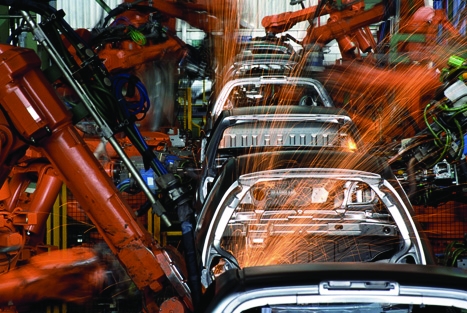
Press-hardened boron steel is an ultra high-strength steel used across a variety of industries, including automotive, where it provides high strength and weight-saving potential, allowing for stronger yet lighter cars, with increased passenger safety.
In the automotive industry, a major joining method for boron steel components is resistance spot welding, with several thousand welds being made on a single car.
Spot welding exposes the boron steel sheet to very high temperatures, causing the metal to exceed melting temperature and then rapidly solidify on cooling. This results in a heat-affected zone, where the surrounding material contracts and its microstructures are altered.
WMG’s Dr Darren Hughes said: “Automotive manufacturers and designers want to understand the exact effects spot welding has on boron steel, as the heat-affected zones can exhibit reduced hardness, which can in turn reduce the components' strength.
“However, most conventional scanning methods will struggle to penetrate such a strong and challenging material so we decided to seek out a partnership with a research facility that could give us access to more powerful means of conducting non-destructive testing – a directed beam from neutrons beams generated by a nuclear reactor.”
The WMG research team formed a collaboration between the Institut Laue-Langevin (ILL) in Grenoble, France, Tata Steel, and EPSRC. The partnership has now begun to use neutrons generated from ILL’s reactor in its SALSA (Strain Analyser for Large-Scale Applications) beamline to examine the welds in boron steel.
WMG Research Fellow Dr Neill Raath, the lead researcher on the project, said: “Our study determined for the first time a strong correlation between reduced hardness in heat-affected zones of boron steel spot welds and increased residual stress. The findings have indicated the need to develop new welding methods that do not have the same damaging impact on mechanical properties as spot welding, especially because there is nothing that can be done to avoid tempering when spot welding is used on boron steel.
“Our study has shown the need to apply alternative welding methods that can lengthen the lifetime of the widely-used boron steel to its full potential. With several thousand welds being made on a single car, future work on minimal-heat input welding techniques and post-spot welding treatments will enable the boron steel components of cars to maintain their hardness and avoid residual stress.
“The next step is to use the same technology to develop methods that can evade this issue. This will include magnetic pulse welding, which does not use heat and as such does not cause a heat-affected zone, and post-welding heat treatment, which reverses the reduction in hardness caused by spot welding. This will be of particular importance to industries that use boron steel such as the automotive industry.”





Project to investigate hybrid approach to titanium manufacturing
What is this a hybrid of? Superplastic forming tends to be performed slowly as otherwise the behaviour is the hot creep that typifies hot...